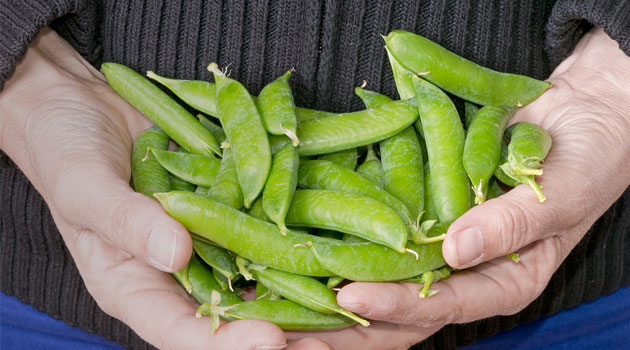Acidity – Soil pH is a measure of acidity or alkalinity. A pH of 7 is neutral, above 7 is alkaline and below 7 is acidic. Most plants prefer soil that is slightly acidic with a pH of 6 to 6.5.
Annual – A plant that has a one-year life cycle.
Bare root – Dormant plants that have been removed from the ground, with their soil also removed, and preserved until later planting.
Biennial – A plant that has a two-year life cycle.
Bolting – Usually the result of excessive heat and sun exposure, bolting occurs when a plant produces premature flowers or seeds instead of a crop.
Botanical name – The scientific name of a plant, consisting of the Genus (always capitalized) and species (not capitalized).
Burwash – The pleasurable cool slosh of puddle water over the top of your wellingtons.*
Clay – Soil that contains 50 percent or more clay. Clay soil is heavy and drains slowly.
Compost – A mixture of decayed plant matter that is used as a soil conditioner, mulch, or fertilizer.
Dead heading – Pinching or snipping off spent flowers.
Deciduous – A plant that loses its leaves each fall or winter.
Direct sowing – Germinating seeds at the planting site rather than growing them indoors to transplant them later.
Dormancy – The period—usually winter—when a plant rests.
Evergreen – A plant that keeps its leaves throughout the growing season.
Family – A term for classifying similar organisms.
Fertilizer – Material that is used to feed plants.
Full sun – At least six hours of direct sunlight each day.
Fungicide – A substance used to control fungi.
Genus – A term for a group of plant species that are closely related.
Germination – The beginning of a seed’s growth.
Groundcover – A low-growing (usually 18 inches or less), spreading plant.
Hardening off – Slowly exposing a plant to cooler temperatures to help it adapt to them (also called acclimating).
Hardiness zone – A geographic temperature zone that categorizes where certain plants can thrive.
Hardy – A plant that can withstand exposure to frost without protection.
Haxby – A garden implement found in a garden shed whose purpose is not entirely clear.*
Heirloom – An open-pollinated plant variety that has remained unchanged for 50 years or more.
Herbicide – A substance that kills plants or inhibits plant growth.
Horticulture – The art and science of plant cultivation.
Humus – Decomposed plant matter that has broken down in the soil.
Hybrid – Crossbreeding of two different plants with distinct characteristics.
Inorganic – Substance derived from non-living material.
Invasive – A plant that is difficult to control.
Loam – Rich soil that contains relatively equal parts of sand, silt, and clay.
Lutton Gowts – Opposite of green fingers – effortless propensity to cause plant death.*
Mulch – Material that helps to cool the soil and/or reduce erosion, evaporation, and weeds.
Native – A term usually used to describe plants that were found growing in a given area before man introduced non-native plants.
Naturalized – To plant without a pattern.
Non-native or exotic – A term usually used to describe plants that were not found in an area before man arrived.
Open pollination – Seeds that develop and grow naturally through wind, insect activity, or soil movement.
Organic – A substance derived from living material.
Ornamental – Plants grown for the way they look, not for consumption or for economic use.
Perennial – A plant that lives for multiple growing seasons.
Pest – A term used for any insect, weed, or plant pathogen (bacteria, fungus, virus).
Pesticide – A substance used to control or kill pests.
pH – A measure of the soil’s acidity or alkalinity of the soil on a scale ranging from 0 to 14. Neutral soil has a pH of 7.
Pistil – The female seed-bearing organ of a flower, consisting of the ovary, style, and stigma.
Poffley End – The green bit of a carrot.*
Pollination – The transfer of pollen from a flower’s stamen to the pistil, which results in the forming of a seed.
Pruning – The process of removing dead, diseased, or damaged leaves or branches.
Raised bed – A garden bed that is elevated off the ground.
Sand – The largest particles of minerals that comprise soil.
Seedling – A plant that has just emerged from its seed.
Self-pollinating – A term to describe plants that do not need pollen from another plant to produce fruit.
Side dressing – The process of working small amounts of fertilizer into the soil surrounding a mature plant.
Silt – Medium-size pieces of minerals that comprise soil (smaller particles than sand and larger than clay).
Sludge – Sediment from wastewater treatment plants that is often used as a fertilizer or as an additive for livestock feed.
Soil – The layer of material on the earth’s crust that is composed of tiny mineral pieces, living and non-living organisms, air, and water.
Soil texture – The proportion of clay, silt, and sand in the soil.
Staking – The practice of using a stick, pole, or other object to support a plant as it grows.
Stamen – The male organ of a flower, consisting of the filament and the pollen-containing anther
Thinning – To reduce the number of seedlings in order to allow better air circulation and light exposure.
Transplant – To remove plants from one location and replant them in another.
Trellis – Latticework that supports climbing plants.
Vermiculite – A light, spongy mineral (also called “mica”) that has been heated to the point of expansion and that can hold water and air.
Waterlogged – Soil that is completely saturated with water.
Weed – A plant growing where it is not wanted and where it adds no value.
Woody – A plant with bark on older stems that usually survive the winter and increase in size each year.
*Courtesy of Douglas Adams The Meaning of Liff

